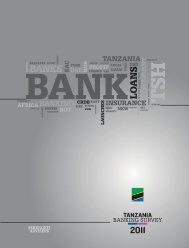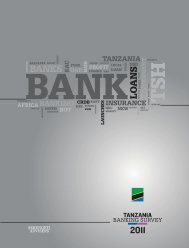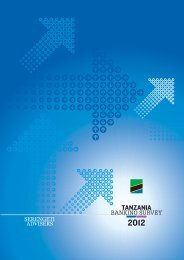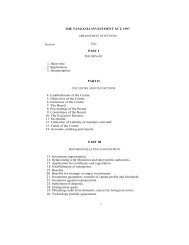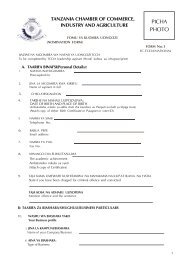Tanzania Cotton Board Annual Report And Accounts
Tanzania Cotton Board Annual Report And Accounts
Tanzania Cotton Board Annual Report And Accounts
Create successful ePaper yourself
Turn your PDF publications into a flip-book with our unique Google optimized e-Paper software.
<strong>Annual</strong> <strong>Report</strong> and <strong>Accounts</strong> for the year ending on 30 th June 2010Performance Overview For The Year 2009/2010An estimated 404,414 ha were sown to cotton during the 2008/09 cropping season. This representeda 10% decline in crop area when compared to the 450,000 ha under cotton in the previous season.The apparent decline in crop area was by and large due to some farmers opting out of cotton for fearof an anticipated decline in cotton prices in the wake of unfolding economic and financial crises. ByNovember and December 2008 farmers had become aware of the two crises and have had aboutwhat was happening to their colleagues in Uganda and other developing countries such as India andChina in the Northern hemisphere. As a result, during 2009/2010 marketing season cotton outputsdeclined by 27% from 368,697 of 2008/2009 to 267,004 tons. The decline was attributable to;1. Farmer’s reaction to anticipated low prices in the wake of unfolding crises;2. The rainfall regime being sub-optimal and poorly distributed during the growing season; and3. Insect attack being unchecked due to most farmers failing to spray their cotton in the aftermathof the suspension of pass book system.Table 1: Seed <strong>Cotton</strong> Production from 2007/2008, 2008/2009 and 2009/2010Zone Region 2009/2010 2008/09 2007/2008Shinyanga 174,162 220,808 128,285Mwanza 59,637 75,744 41,814Mara 10,986 53,283 13,081WCGATabora 4,700 13,451 11,698Kagera 15,650 2,559 4,257Singida 294 1,300 581Kigoma 1,336 1 238WCGA 266,765 367145 199,954Manyara 172 898 540Morogoro 33 307 98Kilimanjaro 6 84 23ECGA Pwani 19 84 47Tanga 5 157 1Iringa 4 23 1ECGA 230 1,552 710Total 267,004 368,697 200,664<strong>Cotton</strong> buying and marketingOfficial 2009/2010 buying season was inaugurated in Musoma District at Mayani village. Duringthis season the number of cotton buyers licensed to buy cotton was only 34 in contrast to 42 duringthe 2008/09 season. The decline was a direct result of bad economic circumstances which hadprompted some buyers to exit the market as a result of financial losses and subsequent failure tosecure bank loans. The two largest regional cooperative unions namely SHIRECU and NCU wereagain involved in cotton buying alongside the private buyers. Producer prices as of 22 nd June were360 shillings per kg of seed cotton. However they rose to 440 shillings per kg by the second weekof July following a government decision to add 80 shilling per kg as an interim measure to boostproducer prices. In the wake of the economic and financial crises, the suggested producer priceof 360 shilling per kg (equivalent to 49 cents per pound FOT) was lower than a suggested priceof 400 shillings (equivalent to 60 cents FOT) offered during the 2008/09 season. The intension ofthe government was to try to stabilize producer prices in the aftermath of the crises. As a result thefarm gate prices of 440/= prevailed throughout the season, in contrast to 540/= peak price in thepreceding season of 2008/2009.7



